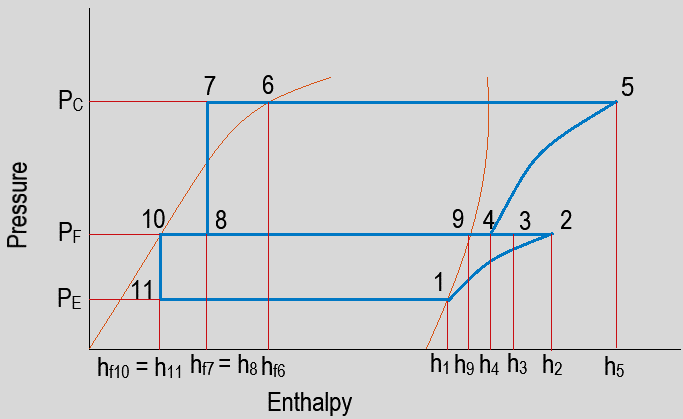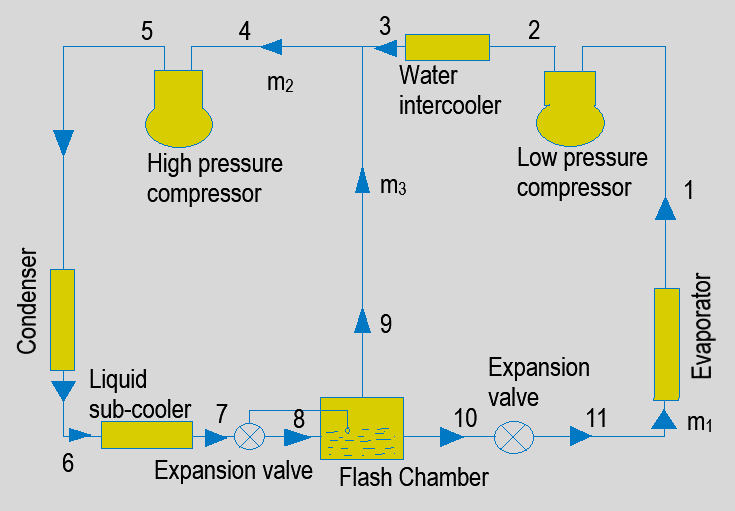This set of Refrigeration Questions and Answers for Entrance exams focuses on “Two/Multi Stage Compression with Water Intercooling, Liquid Subcooling and Flash Chamber – 2”.
1. Why is multi-stage or compound VCR with water intercooler, liquid sub-cooler, and the flash chamber used?
a) To improve C.O.P.
b) To decrease the refrigeration effect
c) To increase work
d) To increase leakage loss
View Answer
Explanation: By de-superheating or intercooling the refrigerant before the second stage compression but not till the saturated vapor line, can decrease the total work required. By using the liquid sub-cooler, subcooling is done, and an increase in the refrigeration effect is achieved. Use of flash chamber ensures the saturated vapor form of refrigerant being entered into the second stage, which also helps reduce the work. So, the increase in R.E. and decrease in work improves the C.O.P. of the system.
2. What is the purpose of using intercooler?
a) To increase the cost of the compressor
b) To cool the superheated refrigerant
c) To re-heat superheated refrigerant
d) To reduce the volumetric efficiency
View Answer
Explanation: Intercooler is used to cool the superheated refrigerant by some amount but in this case, not till the saturated vapor line. The superheated refrigerant leaving the first compressor is cooled by suitable method before entering the second compressor. This type of cooling is known as intercooling.
3. What is the purpose of using liquid sub-cooler?
a) To increase the cost of the compressor
b) To reduce the volumetric efficiency
c) To re-heat superheated refrigerant
d) To increase the refrigeration effect
View Answer
Explanation: Liquid sub-cooler is used to sub-cool the liquid refrigerant coming from the condenser beyond the saturated liquid line. Sub-cooling results in an increase in refrigeration effect and thus increasing the C.O.P.
4. What is the purpose of using a flash chamber?
a) To increase pressure
b) To decrease pressure
c) To separate vapor and liquid refrigerant
d) To evaporate refrigerant partially
View Answer
Explanation: Flash chamber is used to separate vapor and liquid refrigerant. It is an insulated container and separates both forms by using the centrifugal effect.
5. What does process 1-2 and 4-5 represent?

a) Evaporation
b) Compression
c) Condensation
d) Expansion
View Answer
Explanation: Process 1-2 and 4-5 represent compression. This type of compression is isentropic compression, which is carried out in two stages. The first compression is carried out in low-pressure compressor and then compressed in the high-pressure compressor.
6. What does process 2-3 represent?

a) Evaporation
b) Compression
c) Intercooling
d) Condensation
View Answer
Explanation: Process 2-3 represent intercooling or de-superheating. Intercooling is carried out to some extent but not till the saturated vapor line before the second stage of compression. Intercooling results in effective compression in the high-pressure compressor resulting in the reduction of the overall work done.
7. What do PC, PE, and PF represent?

a) Evaporator, expansion and flash chamber pressure
b) Compression, expansion and flash chamber pressure
c) Condenser, evaporator and flash chamber pressure
d) Intercooling pressure
View Answer
Explanation: PC is for condenser pressure. The pressure at which latent heat is rejected from the refrigerant and converting vapor form to liquid form. PE is for evaporator pressure. The pressure at which latent heat of vaporization is absorbed from the medium and phase change from liquid to vapor is carried out. PF is for flash chamber pressure, the pressure at which liquid and vapor refrigerants are separated. Attaining and maintaining these pressures is essential for the smooth operation of the cycle.
8. What does process 3-4 represent?

a) Evaporation
b) Compression
c) Mixing of refrigerant coming from the flash chamber
d) Condensation
View Answer
Explanation: Process 3-4 represent the mixing of refrigerant coming from the flash chamber where intercooling or de-superheating happens. The separated vapor from the flash chamber comes in contact with vapor discharging from first stage compression. This mixture then enters second stage compression in a pure dry saturated state. This results in effective compression in the high-pressure compressor resulting in the reduction of the overall work done.
9. What does process 6-7 represent?

a) Evaporation
b) Compression
c) Mixing of refrigerant coming from the flash chamber
d) Sub-cooling
View Answer
Explanation: Process 6-7 represent sub-cooling. The liquid refrigerant coming from the condenser is cooled further by the circulation of colder water to increase the refrigeration effect and to improve the C.O.P. of the system.
10. What does process 7-8 and 10-11 represent?

a) Expansion
b) Compression
c) Mixing of refrigerant coming from the flash chamber
d) Sub-cooling
View Answer
Explanation: Process 7-8 and 10-11 represent expansion process. The subcooled liquid is expanded in the first expansion valve. Then after the separation of refrigerant in the flash chamber, it is passed through the second expansion valve to do the expansion process.
11. What do process 8-9 and 8-10 represent?

a) Expansion
b) Separating the vapor and liquid form of refrigerant
c) Compression
d) Sub-cooling
View Answer
Explanation: Process 8-9 and 8-10 represent separating the liquid and vapor form of refrigerant. Process 8-9 ensures vapor refrigerant is transferred to the second stage of the compressor. Separates the pure dry saturated vapor and discharges to the vapor coming out of first stage compression. Process 8-10 ensures the saturated liquid is sent to the second expansion valve. The refrigerant reaches a saturated liquid line and then it is expanded.
12. What is the ratio of m3 / m2 for the following arrangement?


If, m1 = Mass of refrigerant passing through the evaporator
m2 = Mass of refrigerant passing through condenser
m3 = Mass of vapor refrigerant formed in the flash chamber
a) (h1 – hf6) / (h2 – h1) – (h4 – h3)
b) (h1 – hf6) / (h2 – h1) + (h4 – h3)
c) (h8 – hf10) / (h9 – hf10)
d) (h1 – hf10) / (h4 – h9)
View Answer
Explanation: Flash chamber is an insulated vessel. Hence, there is no heat exchange between flash chamber and surrounding. Considering the thermal equilibrium,
Heat taken by the flash chamber = Heat given by the flash chamber
m2 h8 = m3 h9 + m1 hf10
as, m1 = m2 – m3
m2 h8 = m3 h9 + (m2 – m3) hf10
m3 (h9 – hf10) = m2 (h8 – hf10)
m3 / m2 = (h8 – hf10) / (h9 – hf10).
13. What is the value of work done for the following arrangement?


If, m1 = Mass of refrigerant passing through the evaporator
m2 = Mass of refrigerant passing through condenser
m3 = Mass of vapor refrigerant formed in the flash chamber
a) m1 (h2 – h1) + m2 (h4 – h3)
b) m1 (h2 – h1) + m2 (h5 – h4)
c) (h8 – hf10) / (h9 – hf10)
d) (h1 – hf10) / (h4 – h9)
View Answer
Explanation: By taking the help of above diagrams,
Work = Work done by low-pressure compressor + Work done by high-pressure compressor
= mass of refrigerant flowing through the low-pressure compressor x enthalpy change + mass of refrigerant flowing through the high-pressure compressor x enthalpy change
Work done by the low-pressure compressor = m1 (h2 – h1)
Work done by the high-pressure compressor = m2 (h5 – h4)
Total work = m1 (h2 – h1) + m2 (h5 – h4).
14. What is the value of work done for the following arrangement?


If, m1 = Mass of refrigerant passing through the evaporator
m2 = Mass of refrigerant passing through condenser
m3 = Mass of vapor refrigerant formed in the flash chamber
a) m1 (h1 – h11) / m1 (h2 – h1) + m2 (h4 – h3)
b) m3 (h1 – hf10) / m2 (h4 – h9)
c) m2 (h8 – hf10) / m1 (h9 – hf10)
d) m1 (h1 – h11) / m1 (h2 – h1) + m2 (h5 – h4)
View Answer
Explanation: As, C.O.P. = Refrigeration effect / Total work
Hence, by taking the help of above diagrams,
R.E. = Heat absorbed in the evaporator
= mass flowing through the evaporator x enthalpy change
= m1 (h1 – h11) as, hf10 = h11
Work = Work done by low-pressure compressor + Work done by high-pressure compressor
= mass of refrigerant flowing through the low-pressure compressor x enthalpy change + mass of refrigerant flowing through the high-pressure compressor x enthalpy change
Total Work = m1 (h2 – h1) + m2 (h5 – h4)
Hence, C.O.P. = m1 (h1 – h11) / Total work
= m1 (h1 – h11) / m1 (h2 – h1) + m2 (h5 – h4).
Sanfoundry Global Education & Learning Series – Refrigeration & Air Conditioning.
To practice all areas of Refrigeration for Entrance exams, here is complete set of 1000+ Multiple Choice Questions and Answers.
If you find a mistake in question / option / answer, kindly take a screenshot and email to [email protected]
- Practice Mechanical Engineering MCQs
- Check Mechanical Engineering Books
- Check Refrigeration & Air Conditioning Books
- Apply for Mechanical Engineering Internship
